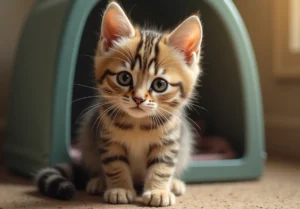Cats are not allowed in Svalbard for a very specific reason – to protect the fragile Arctic ecosystem of this remote archipelago.
Wildlife Preservation
In Svalbard, the delicate balance of the ecosystem is a top priority. Allowing cats to roam freely on the archipelago could spell trouble for the local wildlife, including endangered species like seabirds and polar bears. Cats are natural hunters, and their presence could disrupt the food chain, leading to a decline in certain animal populations. It’s crucial to protect these species and maintain the natural harmony of Svalbard’s environment.
Disease Control
Introducing cats to Svalbard poses a significant risk of disease transmission to the native animal populations. Cats can carry various diseases, such as toxoplasmosis and feline leukemia, which could devastate the already vulnerable ecosystem of the archipelago. Preventing the spread of these illnesses is paramount to safeguarding the health and well-being of the wildlife in Svalbard. It’s essential to uphold strict regulations to maintain the pristine and disease-free nature of this unique environment.
Additional Insight: Did you know that cats are not indigenous to Svalbard and introducing them could upset the established ecological balance? By keeping cats out, authorities are ensuring the preservation of the natural order and protecting the diverse wildlife that calls Svalbard home.
Bird Conservation Efforts
Did you know that one of the main reasons why cats are not allowed in Svalbard is to protect the unique bird species that call the islands home? These tiny creatures are incredibly vulnerable during nesting season, and having cats around could spell disaster for their breeding colonies. By implementing a ban on cats, Svalbard is actively safeguarding these precious birds and ensuring their survival for generations to come.
In addition, the authorities in Svalbard have been working hard to preserve the delicate ecosystem by creating designated protected areas where birds can nest undisturbed. Cats, known for their hunting instincts, pose a significant threat to the bird populations on the islands. Therefore, keeping cats away is crucial to maintaining the fragile balance of the local wildlife and preserving the natural beauty of Svalbard.
Legal Restrictions
When it comes to pets, the laws and regulations in Svalbard are crystal clear – cats are not allowed on the islands. This strict prohibition is in place to protect the environment and wildlife that make Svalbard so special. As a responsible visitor or resident, it’s vital to understand and respect these rules to prevent any harm to the delicate ecosystem.
By prohibiting the presence of cats, Svalbard is sending a clear message about the importance of conservation and sustainable practices. Cats, as predators, can disrupt the natural order of the local fauna and flora. Therefore, adhering to the ban on cats is essential for preserving the unique biodiversity of Svalbard and ensuring a healthy environment for all its inhabitants.
Additional Unique Insight
- Community Efforts: The ban on cats in Svalbard is not just a government mandate – it’s a collective effort by the local community to protect the environment. Residents and tourists alike have embraced the cat ban as a way to show their commitment to preserving the natural beauty of the islands. By coming together in support of this restriction, everyone plays a part in safeguarding Svalbard’s precious wildlife and ecosystems.
Alternative Pest Control Methods
In Svalbard, cats are not allowed due to the potential threat they pose to the delicate ecosystem. Instead of using cats to control pests like rats, the local community has implemented alternative pest control methods that are more environmentally friendly. One effective method is the use of rat traps, which help manage the rat population without introducing non-native predators. Additionally, bird deterrents are employed to protect vulnerable bird species from potential harm. These alternative methods not only preserve the local wildlife but also maintain the delicate balance of the ecosystem in Svalbard.
Cultural Significance
The ban on cats in Svalbard is deeply rooted in the cultural significance of wildlife preservation in the region. The local community holds a profound respect for nature, understanding the importance of protecting the unique flora and fauna found in Svalbard. By prohibiting cats, the residents demonstrate their commitment to preserving the delicate balance of the ecosystem and ensuring the survival of native species. This reverence for nature is a core value held by the people of Svalbard, reflecting their strong connection to the environment and their dedication to maintaining its integrity.
Unique Insight: The ban on cats in Svalbard not only serves to protect the local wildlife but also reflects a broader cultural ethos of sustainability and conservation in the region. This commitment to preserving the natural environment is a central aspect of Svalbard’s identity, shaping the way the community interacts with the ecosystem and prioritizes environmental protection.
Tourism Impact
Listen up, folks! Allowing cats in Svalbard could seriously mess with the tourism game. See, people flock to this place to soak in its untouched beauty and unique wildlife. Picture this: a kitty prowling around, disrupting the peace and scaring off the local birds. Not a good look, right? So, keeping those furry felines out is essential to maintain Svalbard’s charm and draw in those adventure-seeking visitors.
Unique Svalbard Facts
Alright, here’s a juicy nugget for you – did you know that Svalbard is home to the Global Seed Vault, a super cool bunker built to safeguard the world’s plant diversity in case things go haywire? Yup, tucked away in the permafrost, this baby is a crucial stop for preserving our botanical buddies. Plus, Svalbard boasts the 24-hour Polar Night, where the sun takes a snooze for months on end. How’s that for an out-of-this-world experience? So, remember, Svalbard isn’t just any old remote island – it’s a treasure trove of wonders waiting to be explored!
Alex, a passionate animal lover, has experience in training and understanding animal behavior. As a proud pet parent to two dogs and three cats, he founded AnimalReport.net to share insights from animal experts and expand his knowledge of the animal kingdom.




